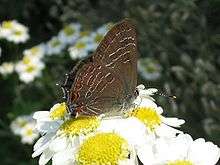Satyrium liparops
| Striped hairstreak | |
|---|---|
 | |
| S. l. strigosa | |
| Scientific classification | |
| Kingdom: | Animalia |
| Phylum: | Arthropoda |
| Class: | Insecta |
| Order: | Lepidoptera |
| Family: | Lycaenidae |
| Genus: | Satyrium |
| Species: | S. liparops |
| Binomial name | |
| Satyrium liparops (Le Conte, [1833])[1] | |
| Synonyms | |
| |
The striped hairstreak (Satyrium liparops) is a butterfly of the Lycaenidae family. It is found in North America,[1] from the Rocky Mountains south from southern Canada to Colorado, east to Maine and south to Florida.
The wingspan is 25–39 mm. The hindwings have one long and one short tail. The upperside is dark brown. The males have a long, oval spot along the forewing costa. The underside of both wings has rows of widely separated white stripes and a blue spot near the tails, which is topped with orange. The outer margin of the hindwings is indented above the short tail. Adults are on wing from July to August in the north and in May in the south. There is one generation per year. Adults feed on nectar from various flowers, including chinquapin, common milkweed, dogbane, goldenrod, meadowsweet, New Jersey tea, staghorn sumac, viburnum, and white sweet clover.
The larvae feed on the plum and cherry (Prunus spp.) and hawthorns (Crataegus spp.).[2] They feed on the buds, leaves, flowers, and young fruit of their host plant.
Subspecies
- S. l. aliparops (Michener & dos Passos, 1942) – (Colorado, southern Alberta to Manitoba)
- S. l. fletcheri (Michener & dos Passos, 1942) – (Manitoba, northern Ontario to Alberta)
- S. l. floridensis Gatrelle, 2001 – (Florida)
- S. l. liparops – (Georgia)
- S. l. strigosa (Harris, 1862) – (Massachusetts, New England, eastern Canada)
References
- 1 2 Satyrium liparops, funet.fi
- ↑ Striped Hairstreak, Butterflies of Canada